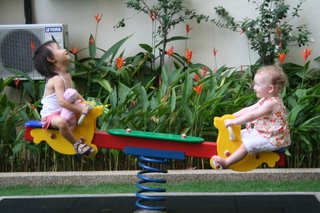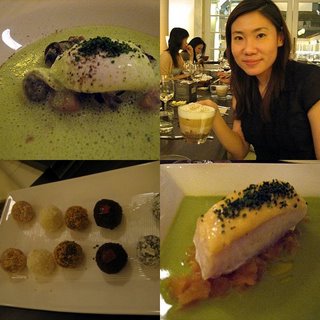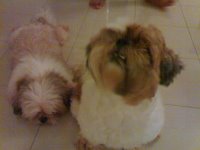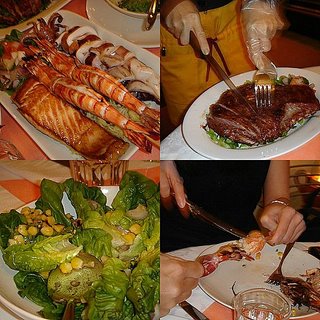
Wow, Cin has invited me to be a guest-blogger on her food blog! Reviewing Made in China, a Chinese restaurant nestled in Haw Par Villa, within the Huasong (“in praise of the Chinese”) museum. Was really looking forward to dining there! Haw Par Villa, despite looking rather forlorn these days, holds great childhood memories for me. I remember it to be a lively, colorful theme park filled with tourists and local visitors. Was especially intrigued by the “18 Levels of Hell” exhibit. Anyway, I thought it was a clever idea to have a restaurant-cum-museum there. Otherwise, who would travel all the way out?
So on Tuesday, Cin and I went to Made in China for lunch with Serene, Neel and Abhi from

work. It was my bday treat from them :) Bloody hot day, so was glad there’s parking close-by. The restaurant is quite a distance from the Haw Par Villa entrance, and Cin mentioned that we were supposed to park near the entrance and stroll up the slope as part of the “experience”! The rest felt we have enough Vitamin D, so parked where it required just a nice short walk to the museum. The restaurant is housed in its main hall. (Note: Bring along your parking coupon and redeem the $5 fee against your dining bill. OCBC credit card gets you a 15% discount!)
First impression – I was disappointed by the decor. Not as impressive as I had imagined! But since this is primarily a food blog, I’ll concentrate on, well, the food! Don’t miss the museum though – it’s very enjoyable. Especially when diners get a complimentary guided tour with Mr Lai; there’s a fee of about $8.40 (adult) $5 (child) for non-diners.

On to the food! Service was prompt and we quickly made our orders. Got the recommended Hakka specialty “Suanpanzi” or “abacus seeds”. Dough made from yam flour and shaped like beads on a traditional Chinese calculator (abacus) are stir-fried with minced pork, diced water chestnuts and shredded black fungus. This was my favourite dish as the “seeds” were much softer and smoother than versions I’ve sampled elsewhere, and the water chestnuts added a really lovely crunch to the dish.
We also ordered the Taiwanese/Southern Chinese specialty “Sanbei Claypot Chicken with Basil Leaves”. “Sanbei” means “three cups”. I was wondering why it’s named that way. Then coincidentally, while watching a food program last night, I found out that it’s because the chicken is cooked with one cup each of vinegar, Chinese wine and dark soya sauce! Actually, I ordered this dish forgetting that Cin doesn’t eat chicken (oops, sorry Cin!). It turned out mediocre. I had the same dish at a restaurant on Yangmingshan in Taipei. Now that was so amazing that I unglamorously slurped and scrapped up every last fragrant bit! This version has too much vinegar, and for some reason, you don’t get the usual lovely aroma from the basil.

Another item we ordered was the “Feicui Toufu” or “jade beancurd”. It’s spinach-topped braised beancurd with vegetables and Nameko mushrooms. This was Cin’s favourite; I say she’s biased because they were generous with the mushrooms! ;-P But it is good… I really liked the lychee peach tea that Cin ordered – cool and refreshing, but it costs a ridiculous $6.75, which we only found out after we got the bill. Wait, but we got two lychees!
We also had some dim sum. Worth mentioning is the

Crispy Banana and Red Bean Roll. A tad oily, but the light sweetness of the moist filling and crispiness of the wrapping was totally satisfying – especially for Abhi with the sweet tooth! Another unique selection is the carrot cake. Unlike the flat squares at other dim sum places, we had cubes of it stir-fried with crabmeat, egg and bean sprouts. Quite tasty, but for $18 a plate, I’d rather have my $2 “black chai tau kweh” at Ghim Moh hawker centre… J
Based on Tuesday’s sampling, I’d come back and try other dishes on the menu – probably more of the provincial signature dishes, and perhaps for dinner. Compared to other provincial Chinese restaurants I’ve tried, Made In China’s cooking is great for diners who like a down-to-earth style of cooking, but with more “refined” tastes – definitely not as “robust” (i.e., heavy on lard and sodium!) as traditional fare. Raymond our waiter told us we should try the Fish Maw Bisque next time. He kept pushing us to try the mooncakes too! He should have given us some free samples – duh! Anyway, we were all stuffed by the time Abhi popped the last bit of char siu bao in his mouth. That’s when we decided to “walk it off” in the museum. Only after that did we troop back to the office… satisfied!




 I then took a bite at my 2nd pasta dish which strangely looked like the usual Beef bolognise to me. And guess what? IT was! The waiter wrote our order wrongly. He quickly made amends by removing the "salty" beef pasta dish and soon, the "correct" crabmeat dish arrived.
I then took a bite at my 2nd pasta dish which strangely looked like the usual Beef bolognise to me. And guess what? IT was! The waiter wrote our order wrongly. He quickly made amends by removing the "salty" beef pasta dish and soon, the "correct" crabmeat dish arrived. any good Italian restaurant. The thin slices of lemon skin in fact tasted odd against the tomato based sauce.
any good Italian restaurant. The thin slices of lemon skin in fact tasted odd against the tomato based sauce.



































